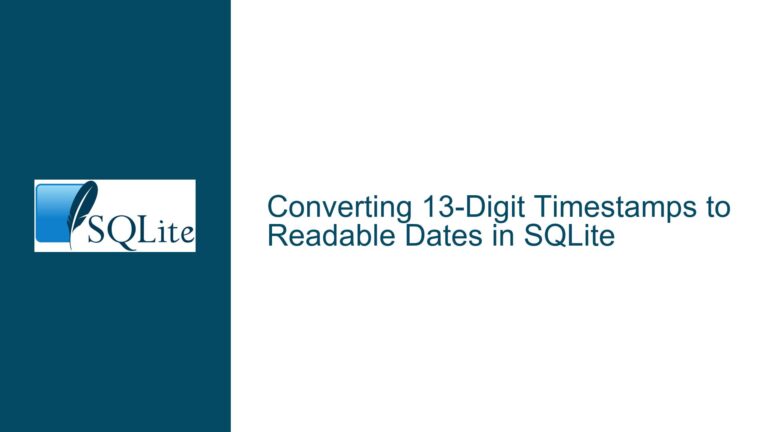Uniqueness of `typeof()` and `hex()` in SQLite: Precision and Pitfalls
Floating-Point Precision and Hexadecimal Representation in SQLite
The combination of typeof() and hex() functions in SQLite is often assumed to provide a unique fingerprint for any given value in a database. This assumption stems from the belief that typeof() accurately identifies the storage class of a value (integer, real, text, blob, or null), while hex() provides a hexadecimal representation of the underlying byte sequence. However, this assumption can break down in specific scenarios, particularly when dealing with floating-point numbers. The core issue arises from the way SQLite handles floating-point precision and the intermediate conversion steps involved in the hex() function.
When a floating-point number is stored in SQLite, it is represented internally as an IEEE-754 double-precision floating-point number. This representation can lead to subtle differences between numbers that appear identical when printed as text. For example, the values 3.1999999999999999 and 3.2000000000000001 are distinct in their binary representation but may appear identical when converted to text. The hex() function, which converts values to hexadecimal, relies on an intermediate text conversion step. This step can obscure the differences between floating-point numbers, leading to non-unique hexadecimal representations for distinct values.
To illustrate this, consider the following SQLite script:
CREATE TABLE t1(x);
INSERT INTO t1 VALUES(3.1999999999999999),(3.2000000000000001);
SELECT typeof(x), hex(x) FROM t1;
The output of this query will show the same typeof() and hex() values for both rows, even though the underlying floating-point numbers are distinct. This behavior occurs because the intermediate text conversion step rounds the numbers to a human-readable format, masking their differences.
Intermediate Text Conversion in hex() and Its Implications
The hex() function in SQLite is designed to interpret its argument as a BLOB and return a hexadecimal rendering of the content. However, for non-BLOB values, such as integers and floating-point numbers, hex() first converts the value to text before generating the hexadecimal representation. This intermediate text conversion is the root cause of the non-uniqueness issue when dealing with floating-point numbers.
For example, consider the following query:
SELECT hex(3.1999999999999999), hex(3.2000000000000001);
Both values will produce the same hexadecimal output because the intermediate text conversion rounds both numbers to 3.2. This behavior is consistent with SQLite’s design philosophy of prioritizing human-readable output over exact binary representation. However, it poses a challenge for users who rely on hex() to generate unique fingerprints for database values.
The issue is further compounded by the fact that casting a numeric value to a BLOB does not preserve its internal binary representation. Instead, the value is first converted to text and then treated as a BLOB. This means that even when using CAST(x AS BLOB), the intermediate text conversion step still occurs, leading to the same loss of precision.
Using quote() and ieee754() for Precise Value Identification
To address the limitations of typeof() and hex() in identifying unique floating-point values, SQLite provides alternative functions that preserve precision. The quote() function returns a string representation of a value that includes sufficient precision to distinguish between similar floating-point numbers. For example:
SELECT quote(3.1999999999999999), quote(3.2000000000000001);
This query will produce distinct outputs, allowing users to differentiate between the two values. The quote() function is particularly useful for debugging and data validation tasks where precision is critical.
Another approach is to use the ieee754() function, which returns the IEEE-754 representation of a floating-point number as a pair of integers representing the mantissa and exponent. This function provides an exact representation of the floating-point value, making it suitable for precise comparisons. For example:
SELECT ieee754(3.1999999999999999), ieee754(3.2000000000000001);
This query will produce distinct outputs, clearly showing the differences between the two values.
To summarize, while the combination of typeof() and hex() is generally reliable for identifying unique values in SQLite, it falls short when dealing with floating-point numbers due to the intermediate text conversion step in hex(). For precise identification of floating-point values, users should consider using quote() or ieee754() instead. These functions provide the necessary precision to distinguish between similar values, ensuring accurate data validation and debugging.
Practical Recommendations for Ensuring Value Uniqueness
When working with SQLite databases, especially those containing floating-point numbers, it is essential to choose the right tools for identifying unique values. Here are some practical recommendations:
Use
quote()for Text-Based Precision: Thequote()function is ideal for generating precise string representations of values, including floating-point numbers. It ensures that subtle differences between similar values are preserved, making it suitable for debugging and data validation tasks.Leverage
ieee754()for Binary Precision: For scenarios requiring exact binary representation, theieee754()function is the best choice. It provides the IEEE-754 representation of floating-point numbers, allowing for precise comparisons and identification of unique values.Avoid Relying Solely on
hex()for Floating-Point Values: Due to its intermediate text conversion step,hex()can obscure differences between floating-point numbers. While it is useful for BLOB and text values, it should not be relied upon for precise identification of floating-point data.Combine
typeof()with Precise Functions: When generating unique fingerprints for database values, consider combiningtypeof()withquote()orieee754()instead ofhex(). This approach ensures that both the storage class and the precise value are accurately represented.
By following these recommendations, users can avoid the pitfalls associated with floating-point precision in SQLite and ensure accurate identification of unique values in their databases.
Detailed Comparison of Functions for Value Identification
To provide a comprehensive understanding of the differences between typeof(), hex(), quote(), and ieee754(), the following table summarizes their behavior and suitability for various data types:
| Function | Input Type | Output Type | Precision for Floating-Point | Use Case |
|---|---|---|---|---|
typeof() | Any | Text | N/A | Identifies the storage class of a value (integer, real, text, blob, null). |
hex() | Any | Text (Hexadecimal) | Low (due to text conversion) | Generates a hexadecimal representation of the value, suitable for BLOBs. |
quote() | Any | Text | High | Provides a precise string representation of the value, including floating-point numbers. |
ieee754() | Floating-Point | Pair of Integers | Exact | Returns the exact IEEE-754 representation of a floating-point number. |
This table highlights the strengths and limitations of each function, helping users choose the most appropriate tool for their specific needs.
Conclusion
The combination of typeof() and hex() in SQLite is a powerful tool for identifying unique values in most cases. However, its reliance on intermediate text conversion makes it unsuitable for precise identification of floating-point numbers. By understanding the limitations of these functions and leveraging alternatives like quote() and ieee754(), users can ensure accurate data validation and debugging in their SQLite databases. Whether working with floating-point numbers, BLOBs, or text data, choosing the right function for the task is essential for maintaining data integrity and achieving reliable results.






